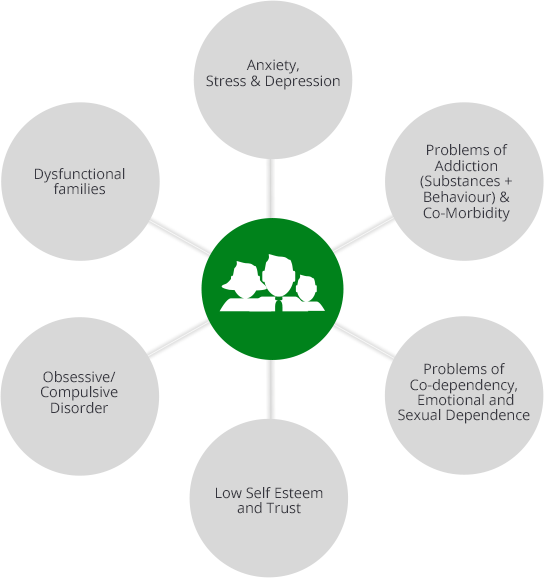ACTIONADDICTION PROVIDES NUMEROUS MULTI-DISCIPLINARY SOLUTIONS
ActionAddiction specialises in the treatment of:
- Dysfunctional families
- Problems of Co-dependency, Emotional and Sexual Dependence
- Problems of Addiction (Substances + Behaviour) & Co-Morbidity
- Obsessive/Compulsive Disorder
- Anxiety, Stress & Depression
- Low Self Esteem and Trust
ActionAddiction uses the most up to date methods in Integrative Psychotherapy such as:
- One-to-One and Group Therapy
- EMDR
- Hippotherapy
- Arts Therapy
Action Addiction works actively in EDUCATION / PREVENTION and provides assistance in the home and the workplace.
Glossary
Group therapy is a psychotherapy session during which several patients are treated at the same time.
The group allows individuals to relive their daily experiences in society within a tiny microcosm. The group provides a sample of reality and what an individual experiences in a group situation is only slightly different to what they experience outside, even though the group amplifies the expression of feelings, conflicts, emotions for practical purposes such as raising awareness.
The support provided by members of the group or merely from the richness of the feedback produced in a group setting, allows a person to realize how others perceive them and in return often causes them to understand some of their relationship problems.
Groups, including groups focused on change, also allow people to practice new attitudes in a protected and supportive environment. In addition, the group promotes the projective identification that is often required in a process of evolution and change. The role of peers is unequalled and cannot be replaced by the role of a counsellor in the context of an interindividual relationship.
EMDR
EMDR therapy is a new psychotherapeutic approach that uses sensory stimulation of both sides of the body, either by eye movements or by auditory or cutaneous stimuli, to induce rapid resolution of symptoms linked to past events. This therapy is a continuation of the clinical and therapeutic research movement that began with psychoanalysis, cognitive behavioural therapy, treatment by exposure, humanistic medicine, systemic therapies and brief person-centred psychotherapy.
EMDR therapy was devised by Francine Shapiro, PhD in the late eighties in San Francisco Bay. In less than ten years, it has become one of the methods of psychotherapeutic treatment of PTSD (Post-Traumatic Stress Disorder) having given rise to a great number of clinical studies. This therapeutic tool is also very effective against the risk of relapse in problems of addiction. EMDR stands for Eye-Movement Desensitization and Reprocessing, although the method is no longer limited to the use of eye movements.
The protocol for EMDR therapy is based on a set of principles which are essential to a humanistic and integrative approach to medicine and health i.e. trust in the ability to self-heal which we all possess, the importance of personal history, a person-centred approach, a power restored, the importance of the link between mind and body, well-being and an improvement in performance.
Hippotherapy uses horses as therapeutic actors to explore emotions. It involves the collaboration between a psychotherapist and a horse professional with clients and horses or ponies to achieve treatment objectives. Because hippotherapy is so intense and effective it is a brief method that is centred on the person, family or group. Hippotherapy can be used to tackle a multitude of mental health problems and personal development needs including behavioural problems, ADHD, PTSD, drug addiction, eating disorders, depression, anxiety, relationship and communication problems.
Why horses?
We are often asked “Why horses? Why not use other animals?”
Horses are large powerful animals that many people find intimidating. This creates a natural opportunity to overcome fear and develop trust. Working alongside a horse, in spite of one’s fears, creates trust and gives an amazing glimpse of the possibilities when other intimidating situations and difficulties arise in life. Above all, horses are a mirror to human body language. Lots of people complain that “this horse is stubborn; this horse doesn’t like me, etc.” The lesson is that if the client changes their behaviour, the horses react differently. Horses cannot lie which makes them particularly powerful messengers. Just like humans, horses are social animals with a defined role in their herds. They prefer to be with their peers. They have distinct personalities, attitudes and moods and an approach that works with one horse may not necessarily work with another. They can seem stubborn and defiant at times. They like to play. In other words, horses offer vast opportunities for metaphorical learning which is an effective technique when working with even the most difficult individuals or groups.
Arts Therapy uses a range of art forms, metaphors and creativity to elicit emotions that are often buried in the unconscious. The process leads to a dialogue that is used to explore the meaning of one’s life. Various tools are used to achieve this, such as:
• Paints, coloured pencils, etc. to allow the inner landscape to be expressed and produce a visual image that can be used as a base for discernment work.
• Puppets and drama can be used to understand relational interactions and the roles that we play to manage them.
• Poetry / Metaphor enables enriched emotional expression beyond words taken individually.
• Modelling clay allows people to create three dimensional forms and promote greater clarity through the sense of touch.
• Music arouses strong emotions from joy to sadness.
• Movement is crucial to support change, body language (stance, gestures, disability)






